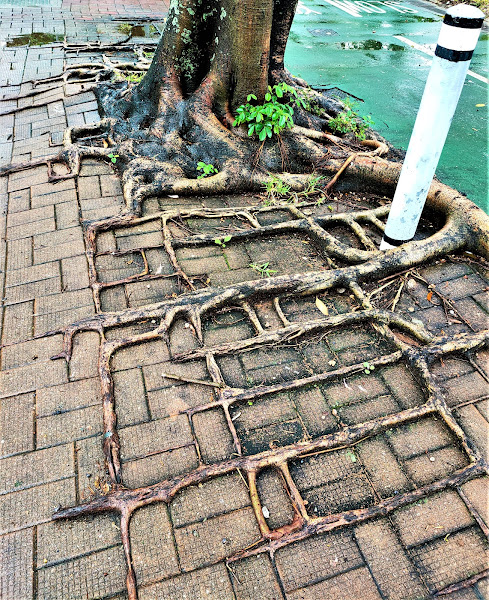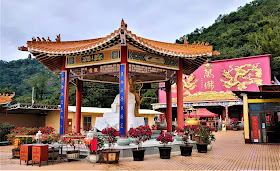You might think that someone who has lived in Hong Kong, off and on, for almost 50 years would be familiar with all the ‘attractions’ that the territory has to offer. But you would be wrong.
A few weeks ago, we received a notification from the local power company informing us that our electricity would be off between 9am and 3pm on a specified day in the near future. That meant no internet, and no point in staying home while the power was off. Paula suggested a bus ride to Sai Kung, but although the Sai Kung peninsula is one of the most scenic places in Hong Kong, I’d lived in the area between 1974 and 1989 and was therefore very familiar with the entire area. And we’d both lived in the area between 2005 and 2008, when we moved to Fanling. I suggested taking a bus to
San Tin, which has quite a few historical buildings, but we’d both visited the place several times.
Then I had a bright idea: why not visit the Ten Thousand Buddhas Monastery in Shatin. I thought I knew precisely where it’s located, because I’d caught a glimpse of a pagoda high on the hillside while passing through Shatin on the train. And that’s where we went for the day.
It took us a while to locate the entrance, but when we did, it was obvious that we’d come to the right place:
The gilded statues are all
arhats (
arhat is a Sanskrit word meaning ‘one who is worthy’, one who has gained an insight into the nature of existence and has therefore achieved
nirvana, spiritual enlightenment, and can thus escape the endless cycle of death and rebirth).
There is only one path, and it’s lined with
arhats:
This is a view looking back down the way we’ve just come:
Incidentally, there are 341 steps on this path, although we didn’t find it particularly arduous because I kept stopping to take photos, including from time to time a close-up of some of the
arhats:
And still the climb continues:
Another close-up:
You might expect that such statues would be endless repetitions of the same figure, but you will have noticed that each one is different, although whether they’re modelled on real people I’m unable to say.
This is a view looking back down the hill from where I took the previous photo:
And there is still some way to go uphill:
A final look downhill:
…although the climb
still continues for some distance:
There is a sharp turn to the left at the top of the steps in the previous photo, and this is a close-up of the figure on the outside of the turn, which you can see in the previous photo:
…and this photo is of the statues to the left of the figure in the previous photo:
Notice the figure on the right with the preternaturally long arm. I don’t know what he’s reaching for.
And this is the final climb:
These are the statues at the top of this incline:
However, when the path levels off, there are more gilded statues:
I don’t know why the figures in the previous photo are female, but they probably represent goddesses.
And then we arrived at a large platform in front of a temple:
The procession of strange figures on the roof of the pavilion are a ubiquitous feature of traditional Chinese buildings: a pilgrim riding what appears to be a donkey; a line of three (you sometimes see four or five) not quite identical mythical beasts; and, finally, someone riding another mythical beast.
I didn’t photograph the white statue in the pavilion, but this is the imposing figure that stands back to back with it:
There is also a nine-storey pagoda on the platform (this is what I could see from the train):
There are other interesting statues around the outer rim of the platform:
I’m unable to say what they mean or who they represent.
And this is the temple:
Note the splendid dragons facing each other on the front. And the bronze tripod, which is there for worshippers to plant burning joss sticks. There are also dragons climbing up each side.
At this point, you may well be wondering about the name of this place. There certainly aren’t 10,000 life-size statues, but there are thousands of tiny gilded buddhas set into niches in the internal walls of the temple. Unfortunately, there are signs expressly forbidding any photography inside any of the buildings, so all I can say is that the cavernous interior is extremely impressive.
There is a short climb to the right from the end of the long climb that brought us here:
And this is the view from the top, looking down:
…while this is close-up of the figures on the outside of the bend:
There is another temple here:
…but the most impressive sight here is the rectangular ‘courtyard’ surrounded on three sides by stone statues:
The previous photo shows part of a design set into this paved area, and this is what the full design looks like:
It features a monad in the centre and the twelve animals of the Chinese zodiac around the outside. Starting with the nearest one in the photo and moving clockwise, these are rabbit, dragon, snake, horse, goat, monkey, chicken, dog, pig, rat, ox and tiger.
This is a closer view of the ten statues at the end of the ‘courtyard’ and what appears to be a tiger in the left-hand corner:
…while this is a closer look at the figures on the right, as viewed from the end of the ‘courtyard’:
There is a stone dragon at the far end in the second photo.
Here are some of the figures on the opposite side:
And there is a goddess with eight arms halfway along the row:
It was only when I examined the photos after I got home that I realized there is an inscription below each statue. I’d categorized the statues as being either warriors, scholars or court officials, but now I wonder whether each one represents a real historical person (they are all male). The inscription under the statue on the left indicates that this is Lo Ching, who, according to the inscription, was ‘a great general’.
There is a smaller temple to the right of the previous one (photographed above):
All the temples here have imposing statues 6–7 metres high inside, on each side of the entrance, and the figure on the left in this temple is actually mounted on a horse and wielding a halberd. As I’ve already mentioned, photography inside the temples is not allowed, so you would need to see these figures for yourself.
To the right of the previous photo is a makeshift fence. According to a leaflet that Paula picked up, there was a landslide here in 1997, probably due to inadequate slope maintenance, and access to a higher level that houses four more temples is currently not possible.
This view of the larger temple, taken from in front of the smaller temple, shows the two dragons on the roof ridge, a common feature on temples here in Hong Kong:
We’d now seen everything that we could see, and it was time to leave. We could have gone back down the way we’d just come up, but we’d noticed steps leading down from the front of the platform I referred to earlier. It seemed prudent to ask someone who was employed by the monastery whether the steps led back down to the valley floor, because I didn’t fancy having to come back up if this exit route was blocked. These steps are much steeper than the ones we’d come up earlier.
There isn’t much to see on this descent route. Just two statues, far apart:
I’m glad we didn’t accidentally find this way up, partly because it’s so steep but also because the lines of gilded statues would not have seemed so impressive on the way down. Finally, I should point out that this is not an historical site. According to the leaflet that I referred to earlier, construction didn’t begin until 1951. But this is still a great place to visit and will be on the itinerary for any guests we have in the future.














































































